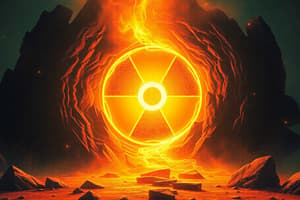Podcast
Questions and Answers
What does N(t) represent in the decay formula?
What does N(t) represent in the decay formula?
- The total number of radioactive nuclei
- The decay constant of the disintegration process
- The number of undecayed parent nuclei at time point 't' (correct)
- The initial number of parent nuclei
What is the relationship between the decay constant (λ) and the average lifetime (τ) of the nuclei?
What is the relationship between the decay constant (λ) and the average lifetime (τ) of the nuclei?
- λ is the square of the average lifetime τ
- λ is the reciprocal of the average lifetime τ (correct)
- λ is twice the average lifetime τ
- λ equals the average lifetime τ
At what time point will the number of undecayed nuclei equal N0/e?
At what time point will the number of undecayed nuclei equal N0/e?
- At one average lifetime (correct)
- At the initial time point
- At two average lifetimes
- At one half-life
How many undecayed nuclei are remaining after three half-lives?
How many undecayed nuclei are remaining after three half-lives?
What does T½ symbolize in the context of radioactive decay?
What does T½ symbolize in the context of radioactive decay?
What is the numeric approximation of Euler's number used in the decay formula?
What is the numeric approximation of Euler's number used in the decay formula?
Which formula represents the exponential decay of radioactive nuclei?
Which formula represents the exponential decay of radioactive nuclei?
What fraction of undecayed nuclei remains after one double half-life?
What fraction of undecayed nuclei remains after one double half-life?
What does the variable N represent in the decay function N(t) = N0 * e^(-λt)?
What does the variable N represent in the decay function N(t) = N0 * e^(-λt)?
Which equation represents the relationship of the initial number of parent nuclei (N0) with the remaining undecayed nuclei over time?
Which equation represents the relationship of the initial number of parent nuclei (N0) with the remaining undecayed nuclei over time?
How is the decay constant λ defined in relation to the average lifetime τ?
How is the decay constant λ defined in relation to the average lifetime τ?
At what point in time is the number of undecayed nuclei equal to approximately 37% of the initial number?
At what point in time is the number of undecayed nuclei equal to approximately 37% of the initial number?
Which of the following statements about half-life (T½) of radioactive nuclei is true?
Which of the following statements about half-life (T½) of radioactive nuclei is true?
If the elapsed time is triple the half-life, what fraction of the undecayed nuclei remains?
If the elapsed time is triple the half-life, what fraction of the undecayed nuclei remains?
What is the form of the decay function that incorporates the half-life T½?
What is the form of the decay function that incorporates the half-life T½?
The decay constant λ has what units?
The decay constant λ has what units?
Why is the function for radioactive decay described as a negative exponential function?
Why is the function for radioactive decay described as a negative exponential function?
What is the numerical approximation of Euler's number (e) used in decay calculations?
What is the numerical approximation of Euler's number (e) used in decay calculations?
Flashcards are hidden until you start studying
Study Notes
Radioactive Decay
- Radioactive nuclei disintegrate over time, decreasing the number of parent nuclei.
- The decay process can be modeled using a negative exponential function: N(t) = N0 e-t = N0 e-t/
- N represents the number of undecayed parent nuclei at time "t"
- N0 is the initial number of parent nuclei
- (lambda) is the decay constant (unit: [time]-1)
- is the average lifetime of the nuclei
- The decay constant can be found by determining the time point on the decay curve where N equals N0/e (approximately 37% of the initial value).
- The decay formula can also be expressed as: N(t) = N0 2-t/T½
- T½ represents the half-life of the radioactive nuclei
- After one half-life, approximately half of the nuclei remain intact.
- After two half-lives, one-fourth of the nuclei remain undecayed.
- After three half-lives, one-eighth of the nuclei remain undecayed.
Studying That Suits You
Use AI to generate personalized quizzes and flashcards to suit your learning preferences.




